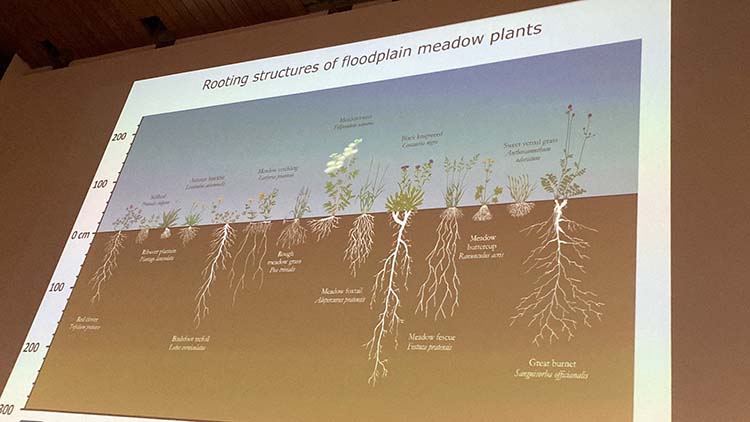Nicky Hodges
The diversity of flowers and grasses in floodplain meadows, their changing patterns and colour over the season is pretty awesome. And they yield high quality hay that cattle love to eat. The 'restoring meadow communities' conference in Oxford gave an intense two-day snapshot of the wonders – and the challenges – of floodplain meadow restoration and brought together many people involved.
I found a series of consecutive presentations about soil structure, carbon storage and micronutrients unexpectedly engaging. They were information-packed and my sneaky screen-shots of charts and mind maps gave me more time to digest it all. Vicky Bowskill’s Shoots to Roots poster beautifully illustrates the deep roots of meadow plants, including common knapweed and bird’s foot trefoil. The presentations explored how those deep roots and good soil structure together make nutrients available to produce high quality hay yields, lock up high rates of carbon in the soil and mean there are plenty of different flowers for insect pollinators.
The organisers clearly knew their crowd and made sure to get us all outside, with a meticulously choreographed and creative learning programme of visits to nearby ancient and restored meadows. On the first afternoon, we played ‘spot the difference’ between the flora of an ancient meadow and a restored meadow. Both had lots of different grasses and flowers, but the restored one had the edge in terms of overall diversity and evenness of spread.
The following morning we followed a learning loop through Music Meadow and Great Meadow to hear about different techniques for collecting and spreading seed for meadow restoration. I enjoyed the story of green hay, express-delivered from a donor to a restoration meadow through Oxford city centre in a muck spreader in a race against time before it started to compost. And the one about anarchist badgers ransacking a newly restored field, only for the yellow rattle to establish magnificently the following spring.
Seed collection using a souped-up horse-dung sweeper as brush harvester avoids the heating effect of green hay and offers more flexible timing. This was presented as a low-cost DIY approach well-suited to wildlife charities. Growing in pots from seed can be a great way to add favourite species to a site and a lovely way to involve children and local residents in meadow restoration.
I enjoyed seeing banded demoiselle damselflies fluttering about Great Meadow and various damselflies at the restoration site. The soil presentations reminded us about the importance of earthworms and other soil invertebrates for good soil. I did worry about the relative lack of bug action in the meadows, as in so many other habitats following last year’s hot summer and general trends of drastically falling numbers.
An important thread through the conference was the importance of adequate recognition and financial reward to farmers and landowners for the public benefits delivered by their maintenance of flourishing floodplains. We heard some inspiring stories of local farmer-led initiatives to restore meadows at farm and landscape-scales. It would have been good to hear how the government intends to support farmers to deliver benefits for nature restoration, flood mitigation and climate change.
Thank you so much to the organisers and to the Oxford Natural History Museum, which is a stunning and apt venue for the the conference.
 Shoots to Roots poster
Shoots to Roots poster